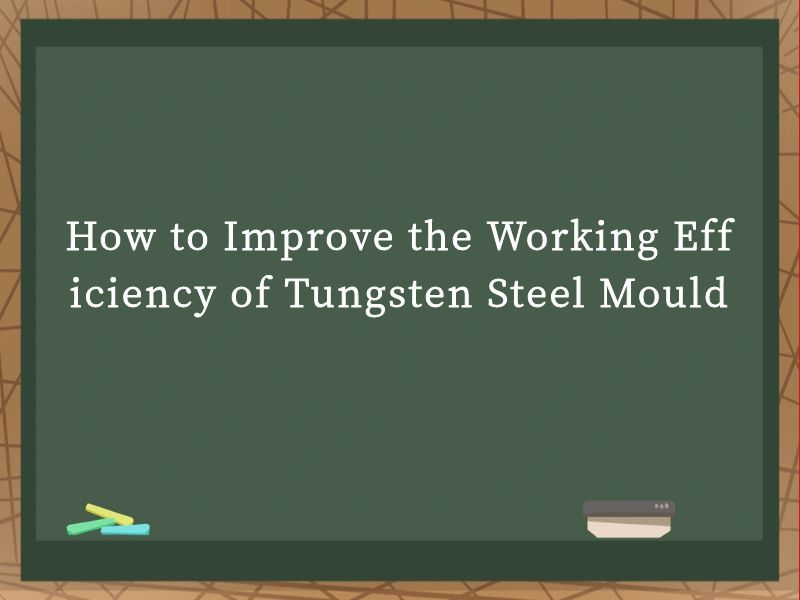JOURNALISM
- NEWS -
|
|
How to Improve the Working Efficiency of Tungsten Steel MouldHow to Improve the Working Efficiency of Tungsten Steel Mould.Tungsten steel moulds are widely used in various industries due to their exceptional hardness, wear resistance, and corrosion resistance. However, despite their robust nature, maintaining and improving their working efficiency is crucial for optimizing production processes and minimizing downtime. This article delves into various strategies that can help enhance the working efficiency of tungsten steel moulds, focusing on practical approaches that ensure sustained performance and longevity.
1. Understanding Tungsten Steel Properties Before discussing efficiency improvement strategies, it's essential to understand the fundamental properties of tungsten steel. Tungsten steel, also known as high-speed steel (HSS), is a type of alloy steel that contains a significant amount of tungsten, along with other elements like chromium, vanadium, and molybdenum. These elements contribute to its high hardness, wear resistance, and ability to retain hardness at elevated temperatures. Despite its advantages, tungsten steel moulds are prone to wear and tear over time, especially under heavy loads and repetitive operations. Therefore, improving their efficiency involves a combination of preventive maintenance, optimal usage practices, and advanced manufacturing techniques. 2. Proper Mould Design and Manufacturing 2.1 Design Optimization The design of the mould plays a pivotal role in its efficiency. Efficient design minimizes stress concentrations, ensures uniform wear, and facilitates easy removal of the moulded product. Here are some key design considerations: Geometry Optimization: Design the mould with smooth transitions and minimal undercuts to reduce friction and ease ejection of the product. Material Flow Analysis: Use computer-aided engineering (CAE) tools to simulate material flow during the moulding process. This helps in identifying potential areas of high stress and wear. Cooling Channels: Incorporate efficient cooling channels to regulate the temperature of the mould, preventing thermal expansion and warping. 2.2 Precision Manufacturing Precision in manufacturing ensures that the mould dimensions are accurate, reducing the need for frequent adjustments and repairs. Advanced manufacturing techniques such as computer numerical control (CNC) machining and electrical discharge machining (EDM) offer high precision and repeatability. CNC Machining: Utilize multi-axis CNC machines to achieve intricate designs with tight tolerances. EDM: For complex shapes and hard-to-machine materials, EDM provides a precise and burr-free finish. 3. Surface Treatment and Coatings Surface treatments and coatings can significantly enhance the wear resistance and durability of tungsten steel moulds. 3.1 Thermal Spray Coatings Thermal spray coatings, such as titanium nitride (TiN) and chromium carbide (Cr3C2), can be applied to the mould surface to improve hardness and reduce friction. These coatings offer a protective layer that shields the base material from wear and corrosion. TiN Coatings: Known for their high hardness and low friction properties, TiN coatings are ideal for applications involving high-speed cutting and forming. Cr3C2 Coatings: Offering excellent wear resistance and thermal stability, Cr3C2 coatings are suitable for heavy-duty applications. 3.2 Plasma Nitriding Plasma nitriding is a surface treatment process that diffuses nitrogen into the surface of the tungsten steel, forming a hard and wear-resistant layer. This treatment enhances the fatigue strength and corrosion resistance of the mould. 4. Optimizing Mould Usage and Maintenance 4.1 Proper Handling and Storage Improper handling and storage can lead to premature wear and damage of tungsten steel moulds. Here are some best practices: Avoid Impact: Handle moulds with care to prevent drops and collisions that can cause cracks or chips. Store in Dry Conditions: Keep moulds in a dry, rust-free environment to prevent corrosion. Use Protective Packaging: Store moulds in protective packaging, such as wooden crates or padded cases, to shield them from physical damage. 4.2 Regular Inspection and Maintenance Regular inspections and maintenance are crucial for identifying potential issues before they lead to significant downtime. Visual Inspection: Conduct regular visual inspections to check for cracks, chips, and wear marks. Dimensional Check: Use precision measurement tools to verify the dimensional accuracy of the mould. Lubrication: Apply appropriate lubricants to reduce friction and wear during operation. 5. Advanced Monitoring and Predictive Maintenance 5.1 Sensor Integration Integrating sensors into the moulding process allows for real-time monitoring of critical parameters such as temperature, pressure, and vibration. This data can be used to optimize the moulding process and predict potential failures. Temperature Sensors: Monitor the mould temperature to ensure it remains within the optimal range. Pressure Sensors: Measure the clamping force and injection pressure to ensure consistent moulding quality. Vibration Sensors: Detect vibrations that may indicate wear or imbalance in the moulding machinery. 5.2 Predictive Maintenance Predictive maintenance leverages data analytics and machine learning algorithms to predict when maintenance is required before a failure occurs. By analyzing historical data and real-time sensor information, predictive maintenance can significantly reduce unexpected downtime and extend the lifespan of tungsten steel moulds. Data Collection: Collect data from sensors and other sources, such as machine logs and maintenance records. Data Analysis: Use advanced analytics tools to identify patterns and trends in the data. Maintenance Scheduling: Based on the analysis, schedule maintenance activities to preemptively address potential issues. 6. Training and Skill Development The efficiency of tungsten steel moulds is also influenced by the skills and knowledge of the operators and maintenance personnel. 6.1 Operator Training Operators should be trained on proper mould handling, setup, and operation procedures. This includes understanding the mould's design limitations, recognizing signs of wear, and knowing when to stop and seek maintenance. Hands-On Training: Provide practical training sessions where operators can practice setting up and operating the mould. Regular Refresher Courses: Offer regular refresher courses to keep operators updated on the latest best practices and technologies. 6.2 Maintenance Personnel Training Maintenance personnel should be skilled in advanced troubleshooting, repair techniques, and predictive maintenance methods. Specialized Training: Provide training on advanced maintenance techniques, such as precision measurement and sensor integration. Certification Programs: Encourage personnel to participate in certification programs that validate their skills and knowledge. 7. Continuous Improvement and Innovation Improving the working efficiency of tungsten steel moulds is an ongoing process that requires continuous improvement and innovation. 7.1 Collaboration with Experts Collaborate with industry experts, research institutions, and suppliers to stay updated on the latest advancements in mould design, materials, and manufacturing techniques. Industry Conferences: Attend industry conferences and trade shows to network with peers and learn about new technologies. Research Partnerships: Establish partnerships with research institutions to access cutting-edge research and development. 7.2 Adopting New Technologies Stay open to adopting new technologies that can enhance the efficiency and performance of tungsten steel moulds. Additive Manufacturing: Explore the use of additive manufacturing (3D printing) for creating complex mould geometries with high precision. Automation and Robotics: Integrate automation and robotics to streamline the moulding process and reduce human error. Conclusion Improving the working efficiency of tungsten steel moulds involves a multifaceted approach that encompasses proper design and manufacturing, surface treatment and coatings, optimized usage and maintenance, advanced monitoring, training, and continuous improvement. By implementing these strategies, manufacturers can significantly enhance the performance and lifespan of their tungsten steel moulds, leading to increased productivity, reduced downtime, and lower maintenance costs. Remember, the key to sustained efficiency lies in a combination of proactive measures and ongoing innovation. By staying ahead of the curve and embracing new technologies, manufacturers can ensure that their tungsten steel moulds remain a valuable asset in their production processes. |


